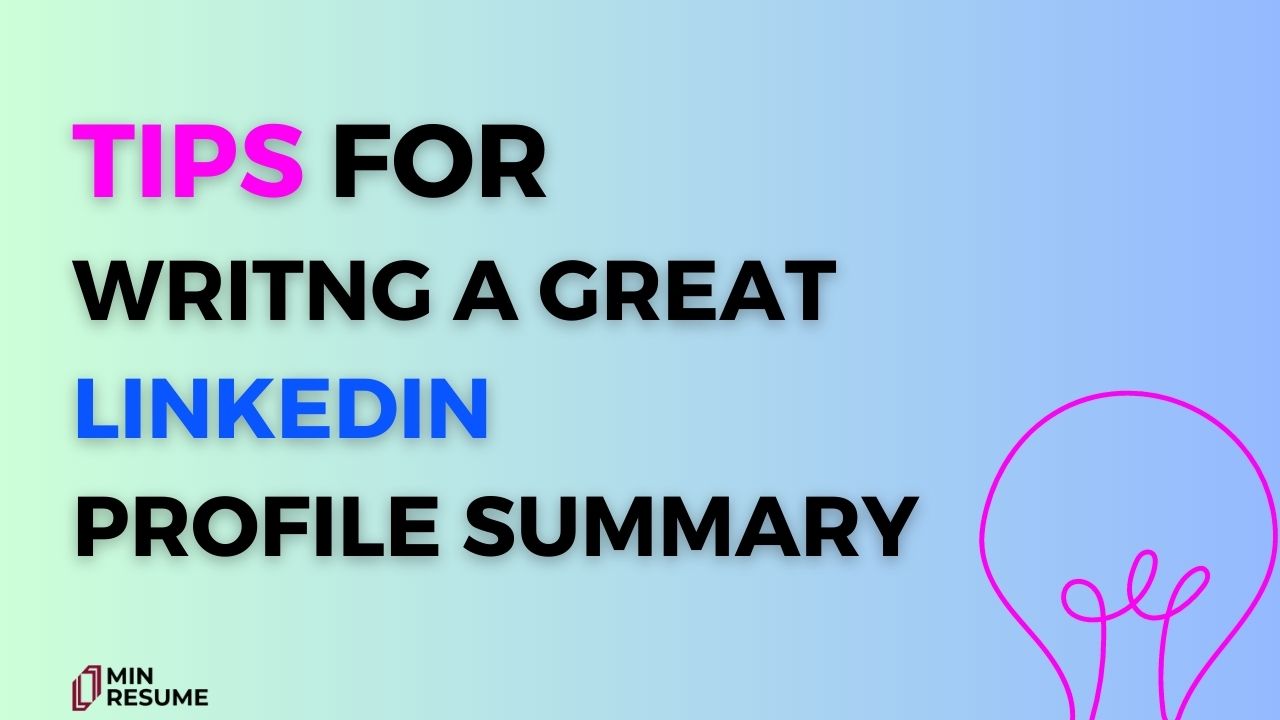Tips to write a great linkedin profile summary

14 June 2023

Writing an Effective LinkedIn Profile for Enhanced Job Opportunities
A good LinkedIn profile is a clear, authentic, and relevant representation of your professional brand. It communicates your expertise, accomplishments, and aspirations, while showcasing your personality and building trust. By focusing on clarity, authenticity, and relevance, and actively engaging with the platform, you can leverage LinkedIn's power to attract opportunities, expand your network, and achieve professional success.
In today's digital age, LinkedIn has become a powerful tool for professionals to showcase their talents and connect with potential employers. Crafting a compelling LinkedIn profile is essential for standing out in a competitive job market and increasing your chances of securing new career opportunities. By strategically optimizing your profile, highlighting your skills, and engaging with the platform, you can greatly enhance your visibility, network, and ultimately, improve your job prospects. In this article, we will explore key strategies and tips to help you write a strong LinkedIn profile that attracts attention, demonstrates your value, and unlocks a world of new job possibilities.
Idea in Brief
A good LinkedIn profile is a concise and compelling representation of your professional brand. It should showcase your skills, experiences, and achievements, while being authentic and relevant to your target audience. By communicating your expertise, building trust, and engaging with the platform, you can leverage LinkedIn to attract opportunities, expand your network, and achieve professional success.
Introduction and Professional Background
The Introduction and Professional Background section of your LinkedIn profile is your opportunity to make a strong first impression and provide an overview of your expertise. It serves as a snapshot of your professional identity, giving readers a glimpse into your skills, experience, and achievements. Starting with a compelling opening statement, you can immediately capture the attention of recruiters, potential employers, and other professionals who visit your profile. Consider mentioning your key accomplishments, area of expertise, or unique value proposition to showcase what sets you apart from others in your field.
This section allows you to delve into your professional background, providing a brief overview of your work history and experience. Focus on highlighting key roles, companies, or projects that are relevant to your career goals. Use bullet points or short sentences to make it easy to scan and digest the information. Emphasize the skills and expertise you have developed over the years, showcasing the breadth and depth of your professional capabilities. By presenting a concise and engaging summary of your professional journey, you can captivate readers and encourage them to explore further.
In addition to showcasing your professional experience, it's important to highlight notable achievements and outcomes from previous roles. Use this section to quantify your success and provide concrete examples of your contributions. This could include metrics, awards, certifications, or any other significant milestones that demonstrate your expertise and impact. By showcasing your accomplishments, you not only validate your skills but also instill confidence in potential employers or clients. Remember to tailor this section to your target audience, focusing on the achievements and experiences that are most relevant and impactful for the opportunities you seek.
Achievements and Differentiation
The Achievements and Differentiation section of your LinkedIn profile is where you have the opportunity to highlight your notable accomplishments and differentiate yourself from other professionals in your field. This section allows you to showcase the impact and value you have brought to previous roles or projects. Mention specific achievements such as exceeding targets, generating revenue growth, or receiving awards and recognition. By highlighting your successes, you demonstrate your ability to deliver results and make a meaningful impact in your professional endeavors.
What sets you apart from others in your field? This section is the ideal place to communicate your unique value proposition and differentiate yourself from the competition. Identify and emphasize your strengths, specializations, or areas of expertise that make you stand out. Share your distinct skills, certifications, or unique approaches to problem-solving. By articulating what makes you different, you position yourself as a valuable asset to potential employers or clients who are seeking someone with your specific skill set and expertise.
To truly stand out, it's essential to showcase your thought leadership and industry contributions. Highlight any thought-provoking articles or blog posts you've written, speaking engagements you've participated in, or industry conferences you've attended. Share any publications or media appearances where you've provided expert insights. By demonstrating your industry knowledge and active involvement, you establish yourself as a trusted authority and someone who stays ahead of the curve. This further differentiates you from others and positions you as a valuable resource for industry-specific opportunities.
Engagement and Call-to-Action
The Engagement and Call-to-Action section of your LinkedIn profile is where you can foster meaningful connections and encourage further engagement with your audience. This section is an opportunity to showcase your communication skills and personality by adopting a conversational tone. Engage your readers by inviting them to connect, collaborate, or learn more about your work. By establishing a friendly and approachable presence, you encourage others to reach out and initiate valuable conversations.
A clear and compelling call-to-action is an essential element of this section. It prompts the reader to take a specific action and indicates how they can engage further with you. For example, you can invite them to connect on LinkedIn, follow your company page, or visit your website or portfolio for more information. Be explicit in your call-to-action and provide easy-to-follow instructions. This not only encourages engagement but also provides a clear pathway for potential employers or clients to learn more about you and your work.
Engagement on LinkedIn goes beyond just your profile. Actively participate in discussions, share valuable industry insights, and support other professionals' content. This section can serve as an invitation for others to engage with you through comments, messages, or collaboration opportunities. By demonstrating your willingness to connect and contribute to the professional community, you establish yourself as an engaged and valuable member of the LinkedIn ecosystem. Continually nurture these connections by responding to messages and engaging with others' content, as this helps to build a robust and mutually beneficial network.
Mastering LinkedIn: Your Path to Professional Success
avigating the intricacies of LinkedIn and crafting a compelling profile can be a game-changer in today's professional landscape. Throughout our conversation, we've explored valuable insights on how to write an effective LinkedIn profile summary, emphasizing the importance of clarity, authenticity, and relevance. By implementing these strategies, you can position yourself as a standout professional, attract job opportunities, and expand your network. Remember to regularly update and engage with your profile, leveraging the power of LinkedIn to its fullest potential. Embrace this platform as your personal brand ambassador, opening doors to new connections, career growth, and ultimately paving the way to your professional success. With dedication, strategic thinking, and a strong LinkedIn presence, you're well on your way to achieving your goals and making meaningful strides in your chosen field.

